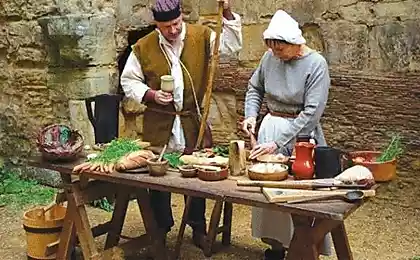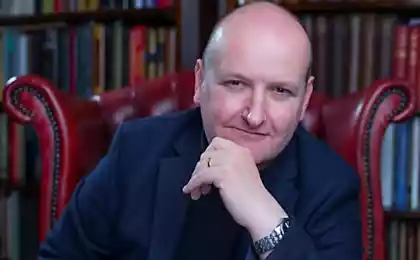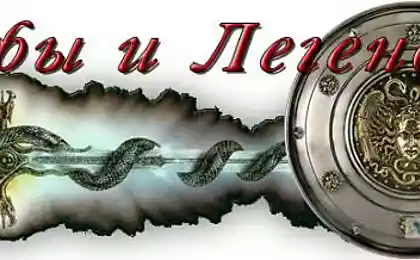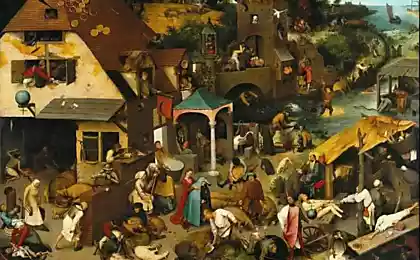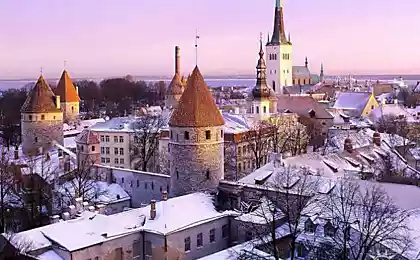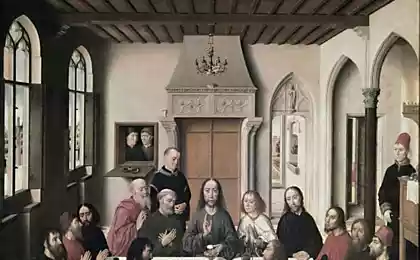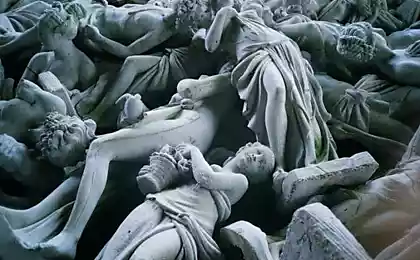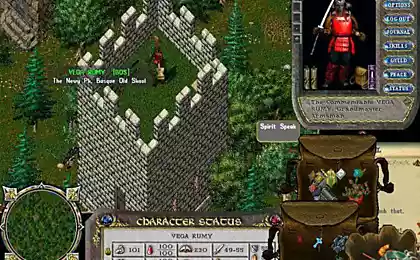843
6 most common myths about the Middle Ages
What picture is most likely to occur in the imagination at the mention of the Middle Ages? Probably something like: gallant knight riding a warhorse among ignorance, dirt and plague. And no wonder - books and movies constantly assure you that in the Middle Ages ...
Source translation for mixstuff - Light Gogol
10 myths and images to them for clarity
1. Scientific progress was dead
Myth:
It is not for nothing called "dark ages." The Catholic Church is alive discourages explore the world around at everyone who dared to it. All knowledge was declared immoral, it was only possible to study the Bible. Not surprisingly, the land in the representation of the people was flat.

Reality:
Well, the first people who believed the planet was flat not far from the majority. Secondly, the Church is not responsible for the decline of science - quite the contrary, it has done much to its prosperity.
After the fall of the Roman Empire, the Catholic Church was the only survivor of an island of Roman culture in Western Europe. Across Europe, the monasteries grew, the glory of the richest libraries. Monasticism was almost the only educated class at the time, and almost all the historical documents that have come to us from the Middle Ages, were written by them.
During the Crusades, Europeans became acquainted with the advanced ideas of the Muslim world in the field of science and technology. Compass and the astrolabe, for example, came to the West from Muslim Spain. Italian merchants brought from North Africa, another innovation - Arabic numerals.
Thanks to the University of Medicine also made significant progress. In fact, autopsy and against the church is not particularly objected that the students were doing, and in the cellars of the medieval universities. By the 14th century, it has functioned hospital, where doctors vengeance cut people sick limbs.
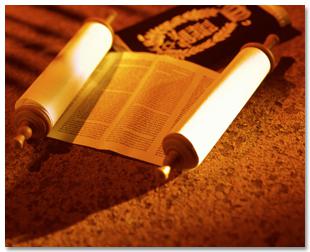
2. Everywhere was unimaginable stench
Myth:
Even those who have never been interested in the history of the Middle Ages, knows that people at that time did not wash, and lived up to their ears in mud. The maximum that afforded very neat - light washing twice a year. And not just any peasants - the important gentlemen could hardly have been much cleaner.
Reality:
In fact, for most of the Middle Ages the situation was far less critical. Yes, especially if no one is turned on the hygiene it was not, but a kind of famous Roman baths still continues to exist. In medieval Germany, for example, public baths existed in most cities, and even in the villages were not such a rarity. They played the role of something like local clubs where you can not only wash, but also to discuss the current news with friends.
In the Middle Ages, is also washed their hands before eating (not all and not always, but still). Moreover, there used to offer swim logged-in guest house.
Demand for the soap (which is made from animal fat with the addition of various aromatic oils and salts) to the 13th century has increased so much that in the UK, Italy, Spain and France, its production reached almost industrial scale.
So why the Middle Ages appear to us so grimy? To blame the plague, dubbed the "Black Death", which is in the middle of the 14th century took place across Europe and instantly changed the way people clean. In those days, doctors decided that mytoe body - is the open pores and open pores - is an invitation for evil spirits and all the nasties. Consequently, the washing - the evil and all the problems of cleanliness.
So skinny and out of fashion.

3. Knights were all noble
Myth:
The Knights were gallant and brave warriors, who are just looking for an opportunity to win some dragon and save the fair lady.

Reality:
Knights often do not looked like this:
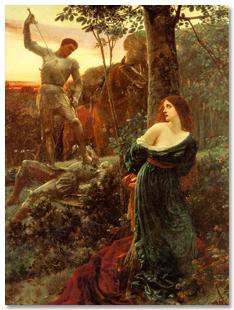
... And this:
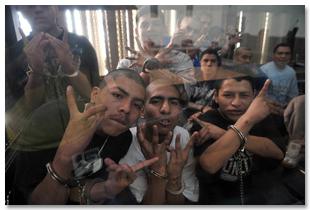
Knights were professional soldiers, and in the intervals between wars, they also had their aggression to do something with. Most of them were quite young men, blood boiling, so that their environment on them getting any - be healthy. By the 11th century many of the local feudal lords found a way to send the tireless energy of the knights in their preferred direction, tying internecine war. It was not like a scene from "Braveheart" is much more like an ordinary bandit raid on villages, looting and killing anyone who gets in the way.
The Church tried to contain these conflicts, because, in truth, they are not good it was to anyone. But the admonitions did not help. And then the Pope blessed the first crusade and had sent all this militant brethren in the Middle East, where they are chivalrous usual massacre.
Later attempts were made to curb violent temper with the help of the Knights' chivalrous code of honor "that was introduced in the 13th century. Images of Lancelot and Edward "Black Prince" were to be examples of how a knight should behave in combat and in civilian life. Knights, for example, was supposed to "protect the weak" - though under the "weak" implies great ladies and their children, not peasants. So cruelty distinguished persons in relation to each other with the introduction of the code of honor may restrain, but to kill and rape farmers still had not shameful. 4. All were hypocrites
Myth:
Casual sex - is a modern invention. In the Dark Ages, people were so religious that about sex outside of marriage did not dare even to think, and every sexually mature person was forced to live permanently suppress their sexual needs

Reality:
Have you ever come across pictures of shoes, which in those days were a man? Such long-nosed about these:
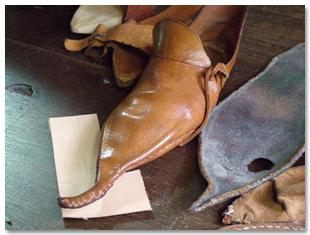
So, these long noses called "Poulain" and they clearly were a hint of the size of his manhood host. Sometimes puleny were so great that the guys could not walk up the stairs.
And fashion sex life in the Middle Ages was not limited. Prostitution was common. Of course, the church did not approve of this activity, but on the other hand, all understood that no prostitutes men just will force indiscriminately, because they like then were still severe. Almost all medieval cities, prostitution existed quite legally, although it was limited to certain neighborhoods.
With all marriages, too, it was not so easy. At the top of society, marriage is almost always concluded for political reasons, no one was interested, like young people to each other or not. So the affair on the side were the only very common way out of the situation. 5. Women were absolutely powerless
Myth:
In the Middle Ages, women were treated as second-class citizens - they could only cook, wash and nurse children.

Reality:
More 200 years ago, Europe was a predominantly agrarian. And work in the field should have all - the famine was a real threat. And when the plow from dawn to dusk, whether here to sexism? And when it comes to working on the house, the man and woman by default it is also equally divided, like a job in the field.
In the cities the situation is not very different. If the father of the family owned shop or tavern, his daughter certainly helped. Sometimes the business could go in full control of his daughter, the father if for some reason are not able to do business.
Those women who did not work in the fields and did not run taverns, could be attached to the monastery. This may not seem very enviable shares, but before the nuns opened the possibility, while rare even for men - they could learn to read and write. Even the great kings - and that has not always been literate. 6. Life was horrible, and all died young
Myth:
Life in the Middle Ages was "painful, rough and short." Food unappetizing, houses without facilities, work hard, in general, everything is terrible. Good thing had to suffer a relatively short time - 35 years, not more. The movie about the medieval character over 60 - always a sorcerer.
Reality:
With regard to life expectancy, it really was approximately 35 years. But the key word here - "average". Infant mortality was very high, as a vaccine against childhood diseases had not yet invented. This fact greatly reduces this same "average" bracket. But if the man of the 16th century lived to 21 years, nobody will be surprised if he will live more years 50.
Typically medieval commoner life seems hopeless, we work on the master, who only knows how to oppress the poor peasants and squeeze all the juice out of them. However, farmers usually worked about eight hours a day, with long breaks for lunch and an afternoon sleep.
In fact, they were even more free time than we do. Sunday - always off, plus Christmas, Easter, the summer solstice and the days of the memory of the great saints. If you count everything together, it turns out that medieval peasants rested third of the year.
And since most of the weekend were the holidays, you can imagine how strong drinks bottle was drunk during this time.
So maybe life in the Middle Ages was not as comfortable as it is today, but not bleak.

Source:
Source translation for mixstuff - Light Gogol
10 myths and images to them for clarity
1. Scientific progress was dead
Myth:
It is not for nothing called "dark ages." The Catholic Church is alive discourages explore the world around at everyone who dared to it. All knowledge was declared immoral, it was only possible to study the Bible. Not surprisingly, the land in the representation of the people was flat.

Reality:
Well, the first people who believed the planet was flat not far from the majority. Secondly, the Church is not responsible for the decline of science - quite the contrary, it has done much to its prosperity.
After the fall of the Roman Empire, the Catholic Church was the only survivor of an island of Roman culture in Western Europe. Across Europe, the monasteries grew, the glory of the richest libraries. Monasticism was almost the only educated class at the time, and almost all the historical documents that have come to us from the Middle Ages, were written by them.
During the Crusades, Europeans became acquainted with the advanced ideas of the Muslim world in the field of science and technology. Compass and the astrolabe, for example, came to the West from Muslim Spain. Italian merchants brought from North Africa, another innovation - Arabic numerals.
Thanks to the University of Medicine also made significant progress. In fact, autopsy and against the church is not particularly objected that the students were doing, and in the cellars of the medieval universities. By the 14th century, it has functioned hospital, where doctors vengeance cut people sick limbs.

2. Everywhere was unimaginable stench
Myth:
Even those who have never been interested in the history of the Middle Ages, knows that people at that time did not wash, and lived up to their ears in mud. The maximum that afforded very neat - light washing twice a year. And not just any peasants - the important gentlemen could hardly have been much cleaner.
Reality:
In fact, for most of the Middle Ages the situation was far less critical. Yes, especially if no one is turned on the hygiene it was not, but a kind of famous Roman baths still continues to exist. In medieval Germany, for example, public baths existed in most cities, and even in the villages were not such a rarity. They played the role of something like local clubs where you can not only wash, but also to discuss the current news with friends.
In the Middle Ages, is also washed their hands before eating (not all and not always, but still). Moreover, there used to offer swim logged-in guest house.
Demand for the soap (which is made from animal fat with the addition of various aromatic oils and salts) to the 13th century has increased so much that in the UK, Italy, Spain and France, its production reached almost industrial scale.
So why the Middle Ages appear to us so grimy? To blame the plague, dubbed the "Black Death", which is in the middle of the 14th century took place across Europe and instantly changed the way people clean. In those days, doctors decided that mytoe body - is the open pores and open pores - is an invitation for evil spirits and all the nasties. Consequently, the washing - the evil and all the problems of cleanliness.
So skinny and out of fashion.

3. Knights were all noble
Myth:
The Knights were gallant and brave warriors, who are just looking for an opportunity to win some dragon and save the fair lady.

Reality:
Knights often do not looked like this:

... And this:

Knights were professional soldiers, and in the intervals between wars, they also had their aggression to do something with. Most of them were quite young men, blood boiling, so that their environment on them getting any - be healthy. By the 11th century many of the local feudal lords found a way to send the tireless energy of the knights in their preferred direction, tying internecine war. It was not like a scene from "Braveheart" is much more like an ordinary bandit raid on villages, looting and killing anyone who gets in the way.
The Church tried to contain these conflicts, because, in truth, they are not good it was to anyone. But the admonitions did not help. And then the Pope blessed the first crusade and had sent all this militant brethren in the Middle East, where they are chivalrous usual massacre.
Later attempts were made to curb violent temper with the help of the Knights' chivalrous code of honor "that was introduced in the 13th century. Images of Lancelot and Edward "Black Prince" were to be examples of how a knight should behave in combat and in civilian life. Knights, for example, was supposed to "protect the weak" - though under the "weak" implies great ladies and their children, not peasants. So cruelty distinguished persons in relation to each other with the introduction of the code of honor may restrain, but to kill and rape farmers still had not shameful. 4. All were hypocrites
Myth:
Casual sex - is a modern invention. In the Dark Ages, people were so religious that about sex outside of marriage did not dare even to think, and every sexually mature person was forced to live permanently suppress their sexual needs

Reality:
Have you ever come across pictures of shoes, which in those days were a man? Such long-nosed about these:

So, these long noses called "Poulain" and they clearly were a hint of the size of his manhood host. Sometimes puleny were so great that the guys could not walk up the stairs.
And fashion sex life in the Middle Ages was not limited. Prostitution was common. Of course, the church did not approve of this activity, but on the other hand, all understood that no prostitutes men just will force indiscriminately, because they like then were still severe. Almost all medieval cities, prostitution existed quite legally, although it was limited to certain neighborhoods.
With all marriages, too, it was not so easy. At the top of society, marriage is almost always concluded for political reasons, no one was interested, like young people to each other or not. So the affair on the side were the only very common way out of the situation. 5. Women were absolutely powerless
Myth:
In the Middle Ages, women were treated as second-class citizens - they could only cook, wash and nurse children.

Reality:
More 200 years ago, Europe was a predominantly agrarian. And work in the field should have all - the famine was a real threat. And when the plow from dawn to dusk, whether here to sexism? And when it comes to working on the house, the man and woman by default it is also equally divided, like a job in the field.
In the cities the situation is not very different. If the father of the family owned shop or tavern, his daughter certainly helped. Sometimes the business could go in full control of his daughter, the father if for some reason are not able to do business.
Those women who did not work in the fields and did not run taverns, could be attached to the monastery. This may not seem very enviable shares, but before the nuns opened the possibility, while rare even for men - they could learn to read and write. Even the great kings - and that has not always been literate. 6. Life was horrible, and all died young
Myth:
Life in the Middle Ages was "painful, rough and short." Food unappetizing, houses without facilities, work hard, in general, everything is terrible. Good thing had to suffer a relatively short time - 35 years, not more. The movie about the medieval character over 60 - always a sorcerer.
Reality:
With regard to life expectancy, it really was approximately 35 years. But the key word here - "average". Infant mortality was very high, as a vaccine against childhood diseases had not yet invented. This fact greatly reduces this same "average" bracket. But if the man of the 16th century lived to 21 years, nobody will be surprised if he will live more years 50.
Typically medieval commoner life seems hopeless, we work on the master, who only knows how to oppress the poor peasants and squeeze all the juice out of them. However, farmers usually worked about eight hours a day, with long breaks for lunch and an afternoon sleep.
In fact, they were even more free time than we do. Sunday - always off, plus Christmas, Easter, the summer solstice and the days of the memory of the great saints. If you count everything together, it turns out that medieval peasants rested third of the year.
And since most of the weekend were the holidays, you can imagine how strong drinks bottle was drunk during this time.
So maybe life in the Middle Ages was not as comfortable as it is today, but not bleak.

Source:



